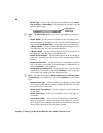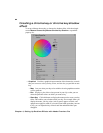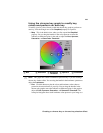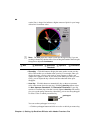93
Creating a chroma key or chroma key shadow effect
$ Auto Key Click this button to automatically key on the most common
color at the current frame in your clip (except gray).
For details on selecting key colors within the graph or performing an auto
key, see “Using the chroma key graph to modify key colors and perform an
auto key” on page 95.
¦NoteYou must expand the Graphical property in order to see the indicator
when adjusting the chroma key controls.
•
Hue Use this to rotate the indicator around the perimeter of the color
spectrum so that you can select different hues (colors) on which to key.
•
Aperture Use this to widen or narrow the aperture of the indicator to
increase or decrease the range of colors on which you want to key.
•
Saturation Use this to select colors that have a particular saturation value.
Pale colors have a low saturation value and are located at or near the center
of the spectrum. Vivid colors have a high saturation value and are located at
or near the perimeter of the spectrum. Because pale colors have low
saturation, you’ll find them more difficult to key on than the vivid colors.
•
Saturation Threshold Use this to proportionally increase or decrease the
region outside of your saturation range. This controls how closely the
Saturation value must match the key color before a region becomes
transparent.
For example, after applying a chroma key effect to a foreground image that
includes dark areas or shadows that you want to preserve in your effect, you
may find that these areas have become semi-transparent. By adjusting the
Saturation Threshold, you can eliminate the key color from these dark areas,
so that they’ll become completely opaque.
•
Softness Use this to soften the edges of your key by blending parts of
your foreground image with your underlying image. This makes certain
areas of your foreground image partially transparent instead of completely
transparent or opaque.
•
Spill Removal Use this to remove the contamination (spill) that your key
color may leave on or around the edges of your foreground image. Spill is
usually caused by light reflecting from your solid color backdrop (key color)
onto your foreground image.
Spill Removal replaces your key color from
the “spill areas” with the opposite color in the spectrum, which returns a
more natural look to these areas.
•
Chroma Suppression Use this to remove any tint that your key color
imposes on your foreground image. For example, if your solid color
backdrop (key color) is green and you are using a person in your foreground
image, the person’s skin may have a green tint. You can adjust the
Chroma


















